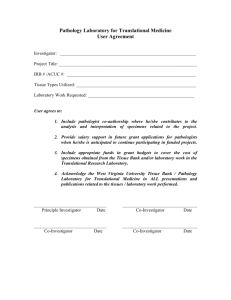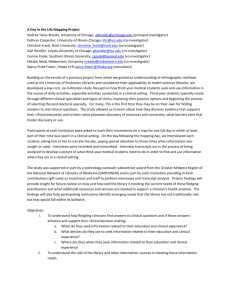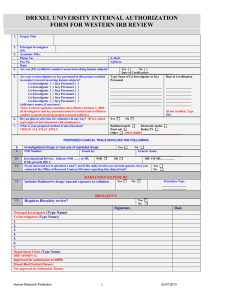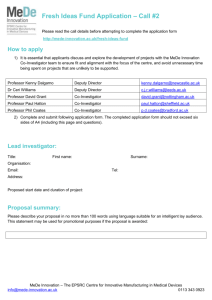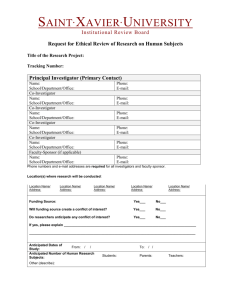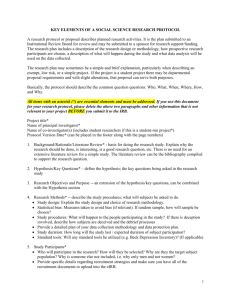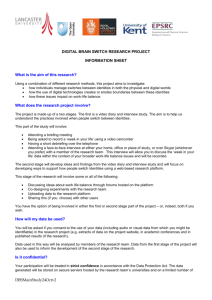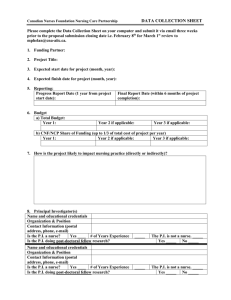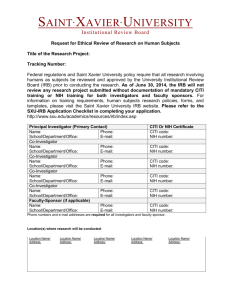1 - California State University, Dominguez Hills
advertisement
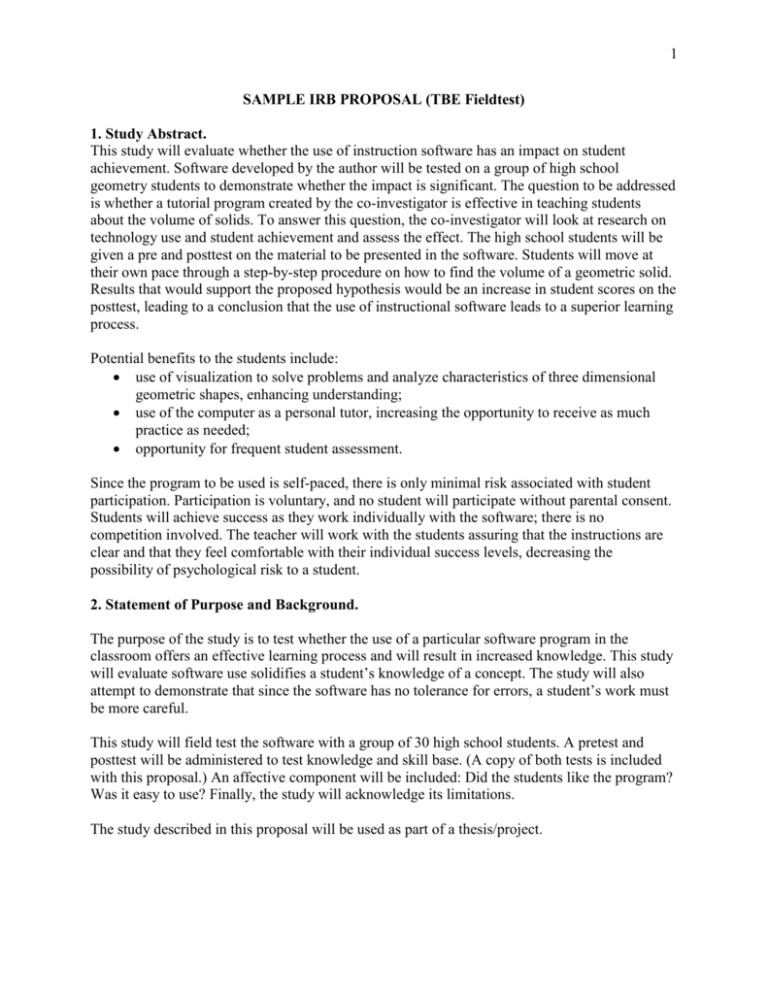
1 SAMPLE IRB PROPOSAL (TBE Fieldtest) 1. Study Abstract. This study will evaluate whether the use of instruction software has an impact on student achievement. Software developed by the author will be tested on a group of high school geometry students to demonstrate whether the impact is significant. The question to be addressed is whether a tutorial program created by the co-investigator is effective in teaching students about the volume of solids. To answer this question, the co-investigator will look at research on technology use and student achievement and assess the effect. The high school students will be given a pre and posttest on the material to be presented in the software. Students will move at their own pace through a step-by-step procedure on how to find the volume of a geometric solid. Results that would support the proposed hypothesis would be an increase in student scores on the posttest, leading to a conclusion that the use of instructional software leads to a superior learning process. Potential benefits to the students include: use of visualization to solve problems and analyze characteristics of three dimensional geometric shapes, enhancing understanding; use of the computer as a personal tutor, increasing the opportunity to receive as much practice as needed; opportunity for frequent student assessment. Since the program to be used is self-paced, there is only minimal risk associated with student participation. Participation is voluntary, and no student will participate without parental consent. Students will achieve success as they work individually with the software; there is no competition involved. The teacher will work with the students assuring that the instructions are clear and that they feel comfortable with their individual success levels, decreasing the possibility of psychological risk to a student. 2. Statement of Purpose and Background. The purpose of the study is to test whether the use of a particular software program in the classroom offers an effective learning process and will result in increased knowledge. This study will evaluate software use solidifies a student’s knowledge of a concept. The study will also attempt to demonstrate that since the software has no tolerance for errors, a student’s work must be more careful. This study will field test the software with a group of 30 high school students. A pretest and posttest will be administered to test knowledge and skill base. (A copy of both tests is included with this proposal.) An affective component will be included: Did the students like the program? Was it easy to use? Finally, the study will acknowledge its limitations. The study described in this proposal will be used as part of a thesis/project. 2 3. Subjects. a. Subject Characteristics: The participants in the study will include 30 high school students chosen from the co-investigator’s period 6 class at XX High School, in YY, Californiia.. The class consists of both male and female students ranging in age from 14 to 17 years old. All are English proficient. b. Selection Criteria: The subjects of this study were purposively chosen because they are members of a class that has not experienced the use of _________ software to enhance learning. The co-investigator (also the teacher) will assess these criteria for inclusion; all students will be invited to participate since they meet the specified criteria. c. Special Populations: Children under the age of 18 will be included. d. Recruitment Source: The subjects for this study, the students and the teacher, will be recruited from XX High School in YY, California. A letter of consent from the principal of XX High School is included with this proposal. e. Recruitment Methods: The subjects of this study will be identified and recruited by me specifically because they are members of the co-investigator’s class at XX High School. f. Informed Consent Process: A letter of consent will be sent to the parents and or guardians of the involved students stating that the study will be voluntary and confidential and that all results will be kept in a locked environment. A copy of the letter is included with this proposal. NOTE: The current IRB says that “standard classroom practice” requires only an information letter, and that no parent/subject signatures are required. Check with your school principal. He/she may still want you to get signatures. g. Study Location: Subjects will participate in this research in the XX High School computer lab. The class will go as a group to the lab during regular class time. h. Potential Problems: Problems involving subject identification, recruitment or data collection are not expected. 4. Research Design and Method. a. Research Design: To test the hypothesis that computer assisted instruction successfully transmits information on _______, 30 high school geometry students will be pre-tested to find their level of knowledge of the subject. Second, they will work through the instructional software. The subjects should be able to complete the tutorial in one class period. Finally, the same students will be retested to see if an increase in scores has occurred. Any student not in attendance for any part of the study will be omitted from the research. To run the teacher-designed program “______”, the students must have a PC with at least four megabytes of RAM available. The computer lab at XX High School has a fully equipped lab; each student will have the above-mentioned computer to work with 3 on this study. There are 36 available computers in the lab. Students will be instructed that they will be using the software to learn about geometric solids. The teacher will circulate through the lab during the lessons to see whether the students need help with the software or the computers. A paired sample t-test will be used to determine whether there is a significant difference between pre-and posttest scores. b. Tests, Questionnaires and Interview Guides: A pre and posttest will be given to all participating students. Each test approximately 15 minutes. After the students have finished using the software, they will complete an evaluation, which should take about 15 minutes. A copy of the pre and post test and of the evaluation are included with this document. c. Deception or Complete Disclosure: N/A 5. Potential Benefits. Direct benefits to the students: Students will receive extra practice working with geometric solids, improving proficiency and mastering needed concepts; the computer allows students to better visualize three dimensional objects and increase their understanding of concepts taught; the computer acts as a personal student tutor; the computer helps prepare students for assessment. 6. Risks. a. Identification of Risk: There are only minimal risks associated with participation in this research. The program is self-paced, allowing students to achieve success. The students work individually; there will be no competition involved. There are no psychological or physical risks anticipated. The teacher will work closely with the students ensuring that they feel comfortable with the program, thereby avoiding psychological risk. Students may feel embarrassed if they do not do well. They may feel uncomfortable using the computer. b. Management of Risk: Students who feel uncomfortable will be told that they may stop participating at any time. Students who do not choose to participate will be given paperand-pencil exercises related to the topic of the computer program. Student pre- and posttest scores will be confidential, so that only the co-investigator will know if a student has a low score. Scores and participation (or non-participation) will not affect student grades. c. Confidentiality: The records of this study will be kept confidential. The co-investigator will not include the name of any student involved in the research in my report. Research records will be kept in a locked file in the classroom. The co-investigator will be the only person who will have access to these records. d. Data Monitoring: Test materials and scores will be kept in a locked environment. 4 e. Assessment of Risk: Only minimal risk to subjects is anticipated. 7. Costs. The subjects of this study will not incur any costs as a result of their participation. 8. Compensation and Incentives. There will be no compensation or incentives offered for anyone involved in this research project. 9. Investigator Experience. a. Brief summary of experience Dr. Fisher, a professor of Graduate Education specializing in Technology Based Education at California State University Dominguez Hills, is an investigator taking a supervisory role for the thesis of co-investigator _______ , a graduate student in the M. A. in Education, Technology Based Education program.
